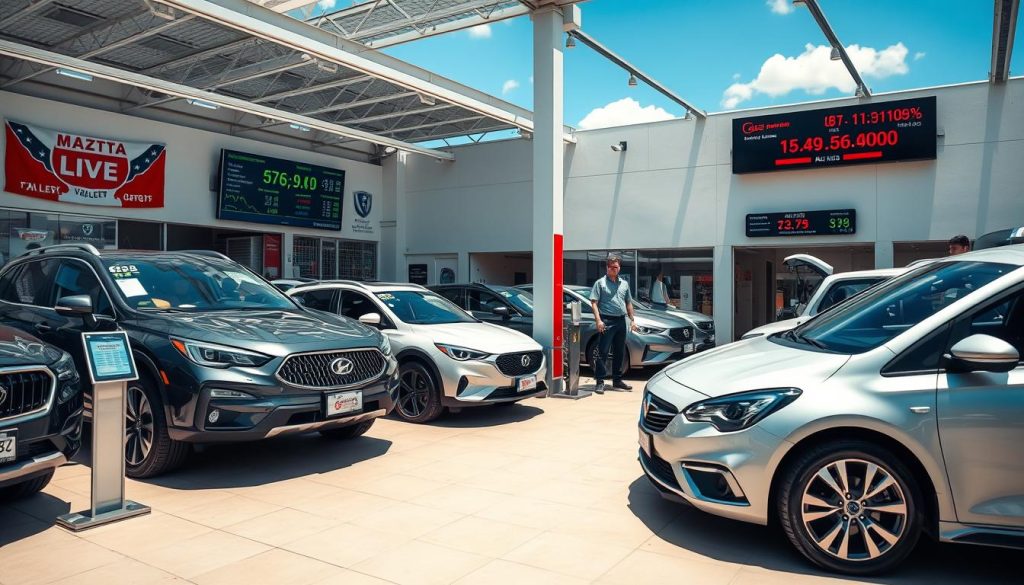Table of Contents
Understanding Kelley Blue Book values is key to knowing your car’s worth. Kelley Blue Book values, or KBB values, set a standard for pricing cars. This helps car owners make smart choices when buying or selling. We’ll dive into car valuation and KBB values to help you figure out your car’s value.

Want to sell your car or just know its value? Kelley Blue Book Value are essential. They give you a precise estimate of your car’s worth, considering mileage, condition, and demand. Knowing your car’s KBB value helps you make better decisions about pricing and valuation.
Introduction to Car Valuation
In the U.S., valuing cars is complex, with many factors at play. KBB values simplify this by offering a standard way to value cars. This makes buying or selling easier. With KBB values, you can trust you’re getting a fair estimate of your car’s worth, based on industry standards.
Key Takeaways
- Understanding Kelley Blue Book values is essential for determining your car’s worth
- KBB values provide a benchmark for vehicle pricing and car valuation
- KBB values take into account factors such as mileage, condition, and market demand
- Knowing your car’s KBB value can help you make informed decisions about buying or selling a vehicle
- KBB values are industry-recognized standards for car valuation and vehicle pricing
- KBB values can help you get a fair estimate of your car’s value
Understanding Kelley Blue Book Value Basics
To figure out used car prices, knowing Kelley Blue Book Value (KBB) basics is key. Kelley Blue Book Value is a top name in the car world, offering a car pricing guide for both buyers and sellers. Since 1926, Kelley Blue Book Value has set the standard for car values.
Kelley Blue Book Value values change based on trade-in values, car condition, mileage, and demand. This info helps car owners decide when to buy or sell. The Kelley Blue Book Value website is full of useful tools, like pricing guides, reviews, and ratings.
- Vehicles’ condition, including any damage or needed repairs
- Mileage, with lower mileage vehicles typically commanding higher prices
- Market demand, which can fluctuate based on factors like seasonality and location
Knowing these factors and using KBB as a car pricing guide helps car owners find their vehicle’s fair market value. This knowledge is crucial for deciding to trade-in or sell your car privately. KBB values are a reliable way to gauge used car prices.
| KBB Value Type | Description |
|---|---|
| Trade-in Value | The amount a dealer is willing to pay for a vehicle |
| Private Sale Value | The amount a vehicle can be sold for in a private sale |
| Retail Value | The amount a vehicle can be sold for in a retail setting |
How Vehicle Age Impacts Your Car’s Worth
Age is a big factor in determining a car’s worth. Car depreciation is a natural process that affects a vehicle’s value over time. As a car ages, its value drops due to wear and tear, new technology, and changing tastes. Knowing how age-related value affects a car’s worth helps car owners make smart decisions about buying or selling.
A car’s vehicle worth depends on many things, like its make, model, mileage, and condition. But age is a key factor that can greatly affect a car’s value. A new car’s value can drop by 20-30% in the first year. Then, it loses 10-15% of its value each year after that. This means a new car can lose a lot of value in just a few years.
To reduce car depreciation and keep a car’s value up, car owners can take a few steps. These include:
- Regular maintenance and repairs
- Keeping the vehicle clean and well-maintained
- Avoiding excessive mileage
- Upgrading to newer models or technologies
By understanding how age-related value affects a car’s worth, car owners can make better choices. Whether you’re buying, selling, or owning a car, remember how age impacts its value. Taking steps to reduce car depreciation is key.
| Vehicle Age | Average Depreciation |
|---|---|
| 1 year | 20-30% |
| 3 years | 40-50% |
| 5 years | 60-70% |
Key Factors That Determine Your Vehicle’s Value
Several factors influence your vehicle’s value. Car pricing changes based on the vehicle’s condition. The vehicle condition is key, as it impacts the car’s worth.
A car in good shape, with low mileage and no damage, can sell for more. But, a car with high mileage, mechanical problems, or damage will sell for less. The regional market also matters, as demand for cars varies by area.
Mileage and Mechanical Condition
Mileage and mechanical health are vital. A car with low mileage and no issues can fetch a higher price.
External Appearance and Damage
The car’s look is important too. A car with no damage or wear looks more appealing to buyers.
Optional Features and Modifications
Optional features and modifications can raise your car’s value. Extras like a sunroof or leather seats can increase the price.
Regional Market Variations
Lastly, regional market variations affect your car’s value. Different areas have different demand for cars, impacting car pricing.
Knowing these factors helps you understand your car’s value. This knowledge aids in making smart decisions about car pricing and negotiations.
| Factor | Impact on Value |
|---|---|
| Mileage | High mileage can decrease value |
| Mechanical Condition | Good condition can increase value |
| External Appearance | No damage can increase value |
| Optional Features | Certain features can increase value |
| Regional Market | Demand can vary by location |
The Role of Market Trends in Car Valuation
Understanding market trends is key to knowing a car’s value. The car world changes fast, with new tech, shifting tastes, and economic ups and downs affecting car valuation. Knowing the latest market trends helps car owners make smart choices when buying or selling.
Several things shape market trends in cars:
- Changes in what people want, like more electric and hybrid cars
- New tech, like self-driving cars
- Things like interest rates and gas prices
By looking at these industry insights, car owners can see how market trends affect their car’s worth. For instance, if many people want a certain car, its price might go up. But if it’s not popular anymore, its price could drop.
It’s vital to keep up with the newest market trends and industry insights to get the most from your car. Whether you’re looking to buy or sell, knowing the current car valuation scene helps you make smart choices and get a good deal.

By keeping these points in mind and staying current with market trends, car owners can confidently deal with the complex world of car valuation. This way, they can make the most of their car investment.
Getting an Accurate Kelley Blue Book Value
To get a precise Kelley Blue Book Value (Kelley Blue Book Value) value, you need to know the steps and what’s needed. KBB values are key for fair pricing in the car market. Start by collecting all needed documents, like the car’s make, model, year, and mileage.
Required Documentation
You’ll need the car’s title, registration, and any repair or maintenance records. Having these ready ensures a correct valuation.
Step-by-Step Valuation Process
The valuation process is simple. You can use the Kelley Blue Book Value website or talk to a dealer. Here’s what you do:
- Enter the car’s make, model, and year.
- Provide the mileage and condition.
- Add any extra features or changes.
- Check and confirm the valuation.
Common Valuation Mistakes to Avoid
Don’t make these mistakes:
- Don’t give wrong mileage or condition info.
- Don’t forget to mention extra features or changes.
- Always review the valuation carefully.
By avoiding these errors, you can get a true Kelley Blue Book Value. This helps you make smart choices about your car.
| Vehicle Type | Kelley Blue Book Value Value | Accurate Pricing |
|---|---|---|
| Sedan | $10,000 – $20,000 | Depends on condition and mileage |
| Truck | $15,000 – $30,000 | Varies based on features and condition |
Understanding Different Condition Ratings
Condition ratings are key in figuring out a car’s value Kelley Blue Book Value (Kelley Blue Book Value) has a system to check a car’s condition. This rating affects its value a lot.
The vehicle condition is judged by its mileage, mechanical state, and looks. Kelley Blue Book Value looks at the car’s history, like accidents or big repairs. Knowing these ratings helps figure out a car’s worth.
Here are the different condition ratings used by Kelley Blue Book Value:
- Excellent: Cars in excellent shape have little wear and no big problems.
- Good: Cars in good shape might have small issues but are mostly well-kept.
- Fair: Cars in fair shape have noticeable problems, like high mileage or damage.
- Poor: Cars in poor shape have big issues, like major mechanical problems or lots of damage.
Kelley Blue Book Value
It’s important to remember that condition ratings can change based on the car’s make, model, and year. Looking into the specific ratings for a car can help understand its value better and how to keep it in good shape.
Trading In vs. Private Sale Values
When selling a vehicle, owners can choose to trade it in or sell it privately. Each option has its own advantages and disadvantages. Trade-in values are generally lower, but trading in is quicker and easier.
Dealers consider the vehicle’s condition, mileage, and demand when trading it in. To get a good private sale price, owners should know their vehicle’s market value. They should also prepare and market their vehicle well. Good negotiation skills are key in both cases to get a fair price.
Some important things to think about include:
- Condition and age of the vehicle
- Mileage and maintenance history
- Market demand and competition
- Negotiation skills and strategies
The choice between trading in or selling privately depends on what matters most to the owner. By understanding the pros and cons of each, owners can make a smart choice. This way, they can get the best price for their vehicle.
| Option | Pros | Cons |
|---|---|---|
| Trade-in | Convenient, quick process | Lower trade-in values |
| Private sale | Potentially higher sale price | More time and effort required |
Seasonal Impacts on Car Values
Seasonal impacts greatly affect car values when selling a vehicle. Knowing these changes helps sellers decide the best time to sell. Getting the right price is all about market timing.
In the U.S., seasonal impacts on car values follow a clear pattern. Summer brings more demand for convertibles and sports cars, raising their car values. SUVs and trucks see a spike in demand during winter, making them more valuable then.

To benefit from these seasonal impacts, sellers should use market timing wisely. For instance, selling a convertible in summer or an SUV in winter can fetch a better price. Keeping up with market trends and anticipating demand changes can also help maximize profits.
Best Times to Sell
- Sell convertibles and sports cars during the summer
- Sell SUVs and trucks during the winter
- Be aware of current market trends and stay ahead of the curve
Market Timing Strategies
Understanding seasonal impacts on car values and using smart market timing can lead to higher sale prices. This way, sellers can get the best value for their cars.
Special Considerations for Luxury and Classic Cars
When it comes to luxury cars and classic cars, their value is special. These specialty vehicles have a rich history. Their condition, rarity, and background greatly affect their worth.
Buyers of luxury cars and classic cars seek a unique experience or investment. Valuing these specialty vehicles needs a deep understanding. This includes their historical significance, mechanical state, and beauty.
To find the value of luxury cars and classic cars, consider these factors:
- Original documentation and paperwork
- Restoration and maintenance records
- Rarity and limited production runs
- Historical significance and cultural importance
Understanding these factors and getting help from experienced appraisers is key. This way, owners of luxury cars and classic cars can ensure their specialty vehicles are valued right. They also keep their value for years to come.
Using KBB Values for Insurance and Loans
Kelley Blue Book Value (KBB) values are key in insurance, financing, and gap insurance. They help you make smart choices about your vehicle. KBB values set a standard for what your car is worth.
For financing, lenders look at KBB values to decide how much to lend. Knowing your car’s KBB value can help you get a better loan deal. Gap insurance decisions also benefit from KBB values, giving you a clear picture of your car’s worth.
Insurance Valuation Methods
Insurance companies use KBB values to figure out how much coverage you need. It’s important to understand these methods to get the right coverage for your car. KBB values also affect loan amounts and interest rates.
Financing Considerations
When financing a car, KBB values are crucial for a fair deal. Lenders use them to set loan amounts, which can lead to better terms. Gap insurance is also influenced by KBB values, helping cover the loan difference if your car is totaled.
Gap Insurance Decisions
Gap insurance is valuable, even more so if you’re financing a car. Knowing your car’s KBB value helps you choose the right gap insurance. It protects you financially if your car is a total loss. With KBB values, you can pick the right gap insurance, ensuring financial security.

Conclusion: Maximizing Your Car’s Value
Understanding Kelley Blue Book Value (KBB) values is key to making your car worth more. Knowing about age, condition, and market trends helps you make smart choices. This is true when buying, selling, or keeping your car in top shape.
Regular maintenance and care are vital for keeping your car’s value high. Keep detailed records, fix problems quickly, and adjust for the seasons. This way, you get the best value from your car.
When trading in or selling your car privately, KBB insights are very helpful. They let you know the fair market value. This knowledge helps you make choices that are good for your wallet.
So, use the Kelley Blue Book as your guide. With a bit of knowledge and effort, you can make sure you get the most from your car.
FAQ
What is Kelley Blue Book Value ?
Kelley Blue Book Value, or KBB, is the top guide for car values. It helps car owners know the right price for buying, selling, or trading in their vehicles.
Why is understanding Kelley Blue Book values important?
Knowing your car’s KBB value is key to getting a fair deal. It helps you negotiate better and avoid paying too much or too little.
How do Kelley Blue Book values differ from other car pricing resources?
KBB is known for its accurate car prices. It looks at many factors like condition, mileage, and market trends. This makes KBB the most reliable source for car values.
What factors influence a vehicle’s Kelley Blue Book value?
Several things affect a car’s KBB value. These include mileage, condition, extra features, and market trends. Knowing these helps you understand your car’s worth.
How can I get an accurate Kelley Blue Book value for my vehicle?
To find your car’s KBB value, you need to give details like make, model, year, and condition. The KBB website has a tool to help you get an accurate value.
What’s the difference between trade-in and private sale values?
Trade-in values are lower because dealers need to make a profit. Private sale values are higher but harder to achieve. They require more effort and time.
How can I maximize the value of my car when selling?
To get the best price, keep your car in top shape. Fix any problems and sell when the market is good. Research and negotiate well to get the most value.
How do I use Kelley Blue Book values for insurance and financing purposes?
Insurance and lenders use KBB values to assess vehicle worth. Knowing how these values are set can help you make smart choices about insurance and loans.





